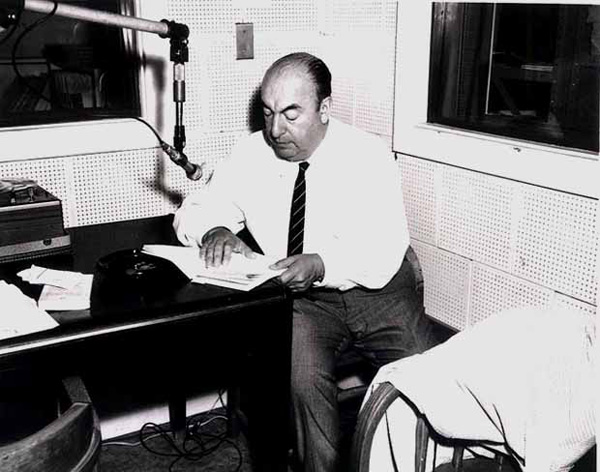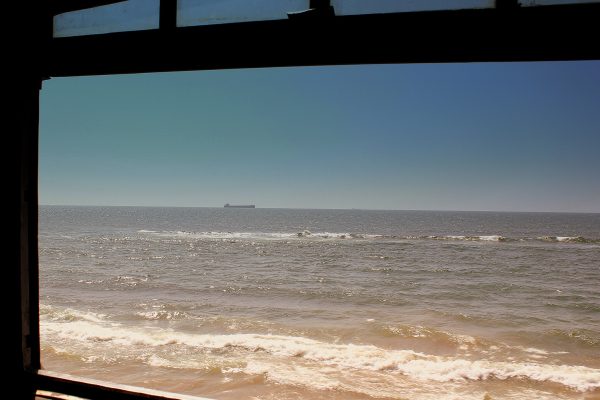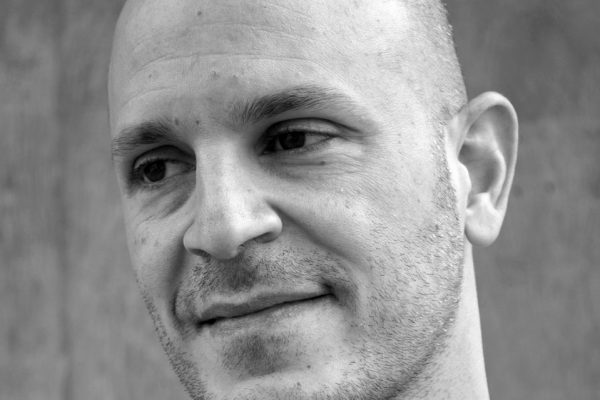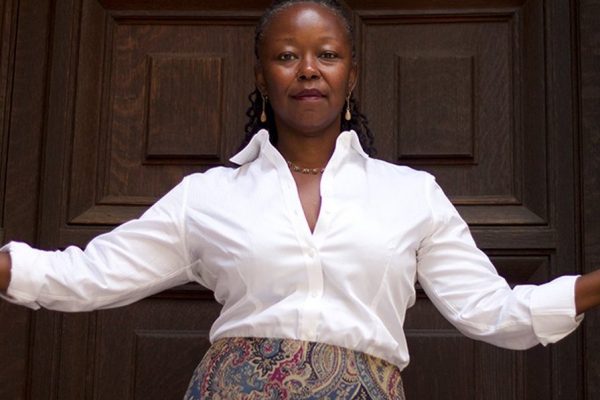Adam Feinstein, a British journalist, is the author of the first biography of Pablo Neruda in English, Pablo Neruda: A Passion for Life (2004). He is also an expert on autism, an interest that emerged when his son Johnny, now 21 years old, was diagnosed with the condition. Feinstein came to Buenos Aires to speak at the second congress on autism, hosted by the Asociación Argentina de Padres de Autistas (APAdeA); I spoke with him at the Bisonte Palace Hotel an hour before he went to dine with Borges’ widow.
“My connection with María Kodama is as a Hispanist,” he told me. “One of my jobs is being an autism specialist, another is teaching at the University of London part time. I’m also finishing a novel, and have started writing children’s poems, as my daughter is getting to the age to read poetry. It’s fun; you can get away with much more and be totally playful. I’m the opposite of autistic; I can’t focus on one thing at all. I need to have ten different projects at any given time, it’s how I work.”
Does a connection exist between Feinstein’s studies of Neruda and autism? There is no obvious link, he admits. Yet as we speak, a number of intriguing themes begin to emerge: the fragility of communication, the significance of intense observation, the question of how to generalize specific experiences by means of metaphor and narration.
“When I found out my son had autism I didn’t know anything about it, but I started looking into the research,” said Feinstein. “When you have a son with a special need, especially this one, you go into denial for a while. There’s a grieving stage, when you think, ‘I’ve lost a son I could have taken to football or the pub.’ But that didn’t last long for me. It was harder for his Mum; she found it very hard, still does. I started a magazine called Looking Up and got to know other parents and professionals. That made me feel less alone, less isolated.”
Medical professionals are divided on how to define autism, but it can broadly be described as a neurodevelopmental condition with strong genetic causes, which often appears as an impairment in social interaction. It may be linked to difficulties in the capacity for empathy: the drawing of connections between one’s own experiences and those of others, the formation of “second order representations” which enable one to attribute others with intentions and beliefs. Non-verbal methods of communication such as eye contact, facial expressions, and body posture are also affected.
“There are lots of children with autism,” Feinstein explained. “You know, the prevalence now is 1 in 68. It falls on a spectrum, and the spectrum has gotten much broader. My son lost his language. He started to speak and stopped; that happens about 25 to 30 percent of the time. That’s the so-called low-functioning end, although some of them can do amazing things. Have you seen Rain Man? Some are like that. Then there’s the high-functioning end of the spectrum, Asperger’s, and you have a lot in between. A lot of people are talking now about ‘autisms’ in the plural, because there are so many different manifestations. Each one likely has a different genetic cause; there may be about 300. It’s a heterogeneous condition, largely genetic but other things can play a role as well.”
At the autism congress, which took place at the University of Buenos Aires law school in late October, Feinstein gave three talks: “Public policies on autism in the United Kingdom and Buenos Aires,” “Workshop for fathers: Life experience. Model of the NAS (National Autistic Society, England)”, and “Borges, Neruda, and Autism”.
Jessica Sequeira: What was your talk “Borges, Neruda, and Autism” about?
Adam Feinstein: I talked about Borges and “Funes el memorioso”, and looked at whether Funes is autistic or just a savant without autism. The argument for him not being autistic is that you don’t usually acquire autism that late, or by falling off a horse. In that story Funes falls off a horse, then remembers everything. That actually happened to Eadweard Muybridge, a very famous British photographer. What happened to him wasn’t as drastic as what happened to Funes, although his memory was greatly affected. The question is whether he was autistic.
It’s a myth that autistics are in their own world. They have a great attachment to certain bits of it, like a blanket.
I think of Temple Grandin, the most famous woman in the world with autism. She designs cattle ranches. An HBO film came out about her life; I know her quite well. She always says that if you ask her to think of a cat or a chair, she can’t think of a generic one. When you think of a chair, you think of a generic chair, don’t you? A generic concept, not a specific thing. But she can’t think of anything but specifics. She thinks of chairs she’s previously sat on; it’s difficult for her to abstract. That’s a phrase from “Funes el memorioso”, “Pensar es olvidar diferencias, es generalizar, abstraer.” [“To think is to forget differences, to generalize, to abstract.”] Funes couldn’t do it. There are some descriptions of him that match Temple Grandin’s way of thinking. She says she thinks in Google Images.
JS: A compilation of specific instances.
AF: Exactly. So I talked about that, then I talked about how unautistic Neruda was in that he was so sociable. He could never be without friends. He had a very lonely childhood in the south of Chile, then this very lonely posting in the Far East, a ridiculous posting in Burma.
JS: Like Orwell, no?
AF: He was either just before or just after; they barely missed each other. Anyway, Neruda hated colonialism, and had an amazing love affair with a native woman called Josie Bliss. There were no Spanish speakers there, and he was going to forget his Spanish if he stayed much longer. He lived a very desolate, isolated life in the Far East. He never forgot those lonely years, and made up for it later by throwing loads of uproarious parties everywhere. So he certainly wasn’t autistic in that way.
I also examined his attitude to objects, which I don’t think is autistic. My son has an obsession with pieces of string. He can just sit there for ages with a piece of string. Often so-called lower functioning autistic children have an object they cling to; with autism, there’s an attachment to the world. It’s a myth that autistics are in their own world. It’s not true. They have a great attachment to certain bits of it, like a blanket. Almost a comfort, just like some people smoke I suppose. But it’s also desperation. I contrasted that in my talk to what happens with Neruda, who didn’t have a desperate need but simply wanted to talk about the beauty of these objects; it’s an outward-looking beauty. If you read some of the odes, you’ll see what I mean. The ode to his socks for instance, or to the artichoke. Attention to detail is common to autism, but maybe Neruda had that too, as a poet.
JS: Perhaps there is some relationship between poetic intelligence and attention to detail, which doesn’t always seek a grander narrative.
AF: There are poets with autism; Donna Williams is a good one. And some of them do use metaphors, which are a move from specific to abstract. People with autism aren’t supposed to be good at metaphors, but some are. But yes, you’re right that attention to detail is very common with them. They can’t see the wood for the trees, but they’re very good at seeing the trees.
I have two memories involving my son. I was doing some work on the computer and he came in and pointed at the screen. I couldn’t see what he was looking at; he was just pointing. I asked, “What’s there, Johnny? What is it?” I blew the little picture up and there was an ice cream, a tiny dot. He made out what it was, which I couldn’t until I blew it up. He loves ice cream. He hadn’t seen the overall picture, just the tiny bit. There was another example of that. The front page of the Guardian had a story about a bus bomb in Jerusalem or Tel Aviv, looking at the aftermath of the explosion. Again, he pointed. I thought, “You’ve gone all political on me or something. What’s happening here?” And there was a tiny piece of string. A tiny, tiny piece of string lying on the floor of the bus. Their minds work in different ways.
People talk about different cognitive styles now. Maybe it’s not a deficit. There’s a movement called the “Neurodiversity Movement” and its whole campaign is for “difference” rather than “disability”. Many people don’t want to be cured. Their autism is part of their identity; they think it gives them valuable traits that can be used positively. If your laptop breaks down, some people on the autistic spectrum, especially those with Asperger’s, are fantastic. They’re very good with computers; they’ve got certain skills. There’s even a company in England called Specialisterne, which started off in Denmark, and that only employs people with Asperger’s, who make brilliant employees. They don’t want to be cured because it would take away a core part of their identity. Temple Grandin says, “If there were a magic pill, I wouldn’t take it to get rid of my autism. It’s what makes me so good at my job.” She calls herself a “cow woman”; she sees through the eyes of a cow. You can see her on her ranch getting down on all fours sometimes to see what the cow is seeing. She’s brilliant.
In my talk another thing I discussed was the fascinating relationship between Borges and Neruda. They first met in 1927 in Buenos Aires. Neruda was on his way to the Far East, and passed through the city. They met and were good friends at that point. They talked about how terrible the Spanish language was, said they should drop it. They were joking, I think. They said English was a much better and richer language but that it was too late, they were stuck with Spanish. And then they moved apart politically, dramatically.
JS: Borges moved right and Neruda left?
AF: That’s basically what happened, yes. And they sniped at each other over their politics. But at the same time, they continued to admire each other as writers and poets despite all their political differences, which in a way is quite moving. They didn’t meet after that as far as we know, but they respected each other hugely. When Neruda got the Nobel Prize for Literature in 1971, Borges was full of praise. He kept saying, “They’ve given it to the right person. They should have given it to him earlier.”
Borges never got the Nobel Prize, as you know, partly because he made some mistakes politically, particularly in 1976 when he went to Chile and received an honor from Pinochet. Famously, the Swedish academy wrote to him to say, “Don’t go to Chile, because if you accept the invitation we won’t be able to give you the Nobel Prize, ever. It’s a dictatorship, a brutal dictatorship.” And he wrote back to say, “I’m going. I don’t accept bribes, and I don’t bribe other people”. I suppose that is admirable in its way, but it was a mistake. He and Neruda moved poles apart, but they recognized each others’ genius. And they were both enormous figures in Latin American culture.
• • •
Feinstein has traveled to more than a hundred countries and compared their responses to autism. He reports his surprise at what he found even in “advanced” countries: “In the United States there was a case of exorcism. Exorcism! The poor boy died.” His observations, as well as interviews with key researchers such as León Eisenberg, María Asperger Felder, Lorna Wing, Michael Rutter, Simon Baron-Cohen, Uta Frith, Rita Jordan, Paticia Howlin, and Gary Mesibov, were published in A History of Autism: Conversations with the Pioneers (Wiley-Blackwell, 2010).
The book is a testament to the shaky history of autism research, which is full of causal theories about emotions and influences with little basis in scientific fact. Feinstein points in particular to the “brutally negative and damaging” influence of the Austrian psychologist Bruno Bettelheim, based at the University of Chicago, whose 1967 book The Empty Fortress claiming parental upbringing is what causes autism in children was, unfortunately, a bestseller.
Today scientists believe the condition is primarily genetic and Bettelheim has largely been discredited. But in Argentina, as in other parts of the world, the burden still largely rest on parents, not so much to avoid creating the “conditions” for childhood autism as to compensate for lack of support from government and private institutions in addressing a preexisting condition. In the program notes to this year’s congress, the APAdeA points out its origin in an immense frustration: “Parents began growing worried when they saw that simple and practical support structures were not being offered. Their experiences and perceptions, the product of an environment of ignorance, were of feeling themselves almost obsessively questioned and observed. Nobody was contributing the scientific explanations necessary to confront the phenomenon and counteract the erosive wave affecting both the child and his family.”
Feinstein started his own magazine, Looking Up, two years after his son was diagnosed. “The magazine is split into two parts,” he said. “The first half is about the latest new findings in genetics and neurology, since it’s a brain disorder. The second half is human interest. There are stories about families and the things people can do, like make art. There are children with autism who are unable to talk but create beautiful paintings, and there are musicians. In the United States you have Matt Savage, who is autistic and a tremendous pianist. Perhaps autistic savants compensate for their problems with other kinds of intelligence. There’s still a lot that we don’t know.”
JS: What was the context in which you brought out the magazine?
AF: In ’98, the year I began the magazine, the MMR vaccine was brought out, the triple vaccine for measles, mumps, and rubella. Then a gastroenterologist from England named Andrew Wakefield published a paper announcing there were links between autism and the triple vaccine. There was absolutely no scientific evidence for this whatsoever. But it caused a lot of panic; parents stopped giving their children the MMR. They tried to give them separate vaccines, measles one year, mumps the next, and while they were waiting many children got sick. Some didn’t get the vaccine at all and died because of it.
It brought back the whole blame game; once again, parents were at fault. It also gave a negative image of autism, something I always bring up in my talks. I suggest we ought to focus on the positive side of autism, the things autistic adults and children can do rather than what they can’t. If you say to a parent that you shouldn’t give your child the MMR because it will cause autism, it almost implies it’s better to have measles than autism. That’s the kind of opposition set up in people’s minds, whereas most autistic children are really healthy. My son is very physically healthy, though he can’t talk.
The primary conference organizer is Horacio Joffre Galibert, the Argentine lawyer who founded APAdeA. Galibert has drawn up key disability laws in Argentina such as Ley 24.901 (which alleviates out-of-pocket costs for mental health-related care) and Ley 26.378 (which ensures equal rights for the disabled).
“I’m the father of a 32 year old, severely autistic boy,” he introduces himself. “The congress began in ’94, when we brought the country’s autism researchers together to look at the state of the field in Argentina. When we started, we had three goals. The first was to pass laws, the second was to push aside the prevailing simplistic psychoanalytic and medical responses, the third was to strengthen support networks.
JS: How would you describe your ideas on autism education?
Horacio Joffre Galibert: We wanted to change the paradigm and raise ourselves to the level of the rest of the world, especially that in Central Europe, England, and some parts of the United States. The alternative to psychoanalysis or medicine is autistic centers, residencies, and retreats for parents which allow them to take a weekend of rest. We’ve been working to radically change the idea of education in terms of school integration and inclusive education. People with autism are starting to go to normal schools with teachers prepared for them. And we’re changing the mentality of doctors, especially pediatricians.
JS: What’s it like trying to do so in this country?
HJG: Argentina is very complicated with respect to how health issues are addressed, and to the bureaucracy and funding of health care, especially mental health. To diagnose autism there are three entirely different vademécums, diagnostic systems, in place. Previously there were also asylums. You could leave your child in psychiatric warehouses like the Borda or the hospital in Lanús. But the state wouldn’t take charge of them; the children would self-destruct and the state would do nothing. And so in most cases autistic people lived with their parents, as they still do.
We wanted a revolution in Argentina; we wanted to change things. And we’re beginning to get results. We’re in a moment of transition but are on the right track. As parents we’re breaking with the old system to create a new one. It’s taken us twenty years to get here. This is a revolutionary process, not something that happens overnight.
At one point during our conversation, I asked Feinstein why he thought Neruda never mentioned his disabled daughter in his memoirs. He paused. “I wish I could ask him now,” he said. “I think it was very painful. She was born in Spain, and he continued to go out drinking and socializing while his wife looked after the child. He’d been looking forward to being a father, and was proud of his daughter at first, but ultimately he couldn’t cope with the disability. That happens with autism too; there are many family break-ups, many divorces. A lot of fathers can’t take it. It’s usually the fathers who leave, the mothers who are left behind. There are many cases of couples going through legal battles together as well though. Even in my country, England, there are still challenges. In Argentina, the organization that Joffre set up twenty years ago has transformed an entire country’s thinking about a condition. It’s extraordinary, really.”
Read the second part of the conversation with Adam Feinstein, in which he discusses his engagement with Neruda’s poetry.








